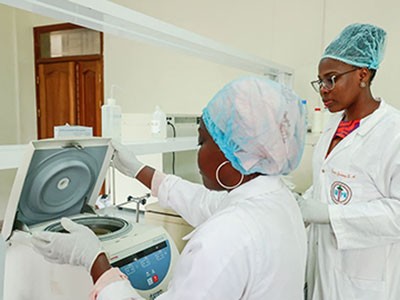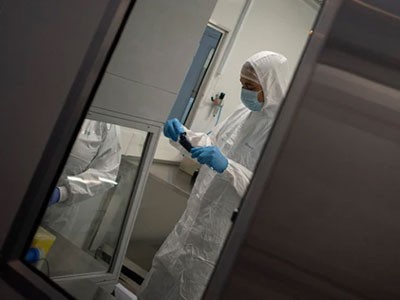You have full access to this article via your institution.

People in African countries waited longer to receive COVID-19 vaccines than did people in high-income countries.Credit: Robert Bonet/NurPhoto/Getty
Who would have thought that the proverbial red carpet would be rolled out for a regulatory agency? That is what happened — and rightly so — with today’s launch of the African Medicines Agency (AMA), which is headquartered in Kigali.
As Nature Africa’s news team reports, the AMA is the most important development for health and science in Africa in years. Medicines regulators are the hidden stars of public health. It is their job to ensure that the pills we consume and the vaccines we receive are quality products, safe to use and do what they say on the label. The AMA has been a decade in the making (B. M. Ncube et al. J. Pharm. Policy Pract. 14, 29; 2021). Now that it has become reality, it must succeed.
Africa finally has its own drug-regulation agency — and it could transform the continent’s health
The idea of a single medicines regulator for the African continent comes some 30 years after the creation of the European Medicines Agency (EMA), the European Union’s one-stop regulator, now based in Amsterdam. The EMA, which has been advising and funding the AMA during this initial phase, has a number of roles. High on the list is providing scientific advice on proposals for new medicines, vaccines and other medical products. This is often guidance on improving the design of studies so that they are as robust as possible.
However, the EMA is arguably best known for evaluating the safety and efficacy of products after laboratory tests and clinical trials. It can recommend authorization of a drug or vaccine so that it can be sold across the EU, but the actual decision to make it available rests with the European Commission and national regulatory bodies.
The AMA will draw on this experience, but its operating environment couldn’t be more different from that of European countries. The EU is home to some of the world’s largest pharmaceutical companies and some of the best-funded research groups in the areas that it regulates. African countries, by contrast, import more than 70% of medicines and 99% of vaccines. Each EU country has its own national regulatory body for medicines that takes care of authorizing clinical trials, another important part of the regulatory chain. Only 9 of 55 African Union member states have national regulators that have achieved the necessary quality threshold to be allowed to do this, as determined by the World Health Organization (N. Wairagkar et al. PLOS Glob. Public Health 5, e0004276; 2025). They are not authorized to approve vaccines and drugs — another reason why so many countries rely on imported products.
What the launch of the African Medicines Agency means for drug and health regulation
This means that, compared with its European counterpart, the AMA will need to do a lot more training and capacity building so that national authorities have the expertise needed to authorize medicines. It will need to work with universities, funding agencies and industry to build and establish research partnerships.
A core priority will be setting standards for the design and evaluation of clinical trials. Of some 1.3 million clinical trials conducted around the world between 1999 and 2024, less than 3% took place in Africa, write Mwila Mulubwa, Leon Mutesa and Kelly Chilabe in a Comment article in this week’s issue. This must be improved because, as the authors say, African populations are being given treatments that have not been properly tested among the people there, and could therefore be ineffective, or even detrimental. They recommend that the AMA should require candidate medicines and vaccines to be appropriately tested in Africa — both in clinical trials and (at the preclinical stage) using models derived from cells or tissues from individuals of African ancestry.
Funding and the future
A key question is who is going to pay for all of this. Regulatory bodies don’t come cheap — and they are often not a priority for governments when money is tight, as is the case now. The EMA costs around €600 million (US$694 million) to run each year. Estimates for the AMA are a lot lower. For the first five years, roughly €100 million has come from international donors — the European Commission, the EMA and two charitable foundations, the Gates Foundation in Seattle, Washington, and Wellcome in London. But in the medium-to-long run, African Union member states must find a way to shoulder more of the costs. The sudden decision this year by the United States to cease funding its overseas development agency, USAID — and the disaster it has wrought on whole communities of its beneficiaries — is a reminder of the risks of health systems relying wholly on external funders.
Africa is bringing vaccine manufacturing home
If the AMA is to have a stable local funding base, it needs to be fully supported by everyone on the continent. Twenty-five countries have fully ratified the treaty that brought the AMA into force, giving it the formal seal of approval within their national laws. The rest need to complete ratification without delay.
The COVID-19 pandemic laid bare the inequity at the heart of global health care. Countries that had thriving pharma industries and lots of cash procured vaccines more quickly than those that didn’t. African Union member states were right to declare a goal to bring manufacturing home to the continent. That requires safe, efficient and effective regulatory frameworks. The launch of the AMA is a key part of that process, and it must succeed.





